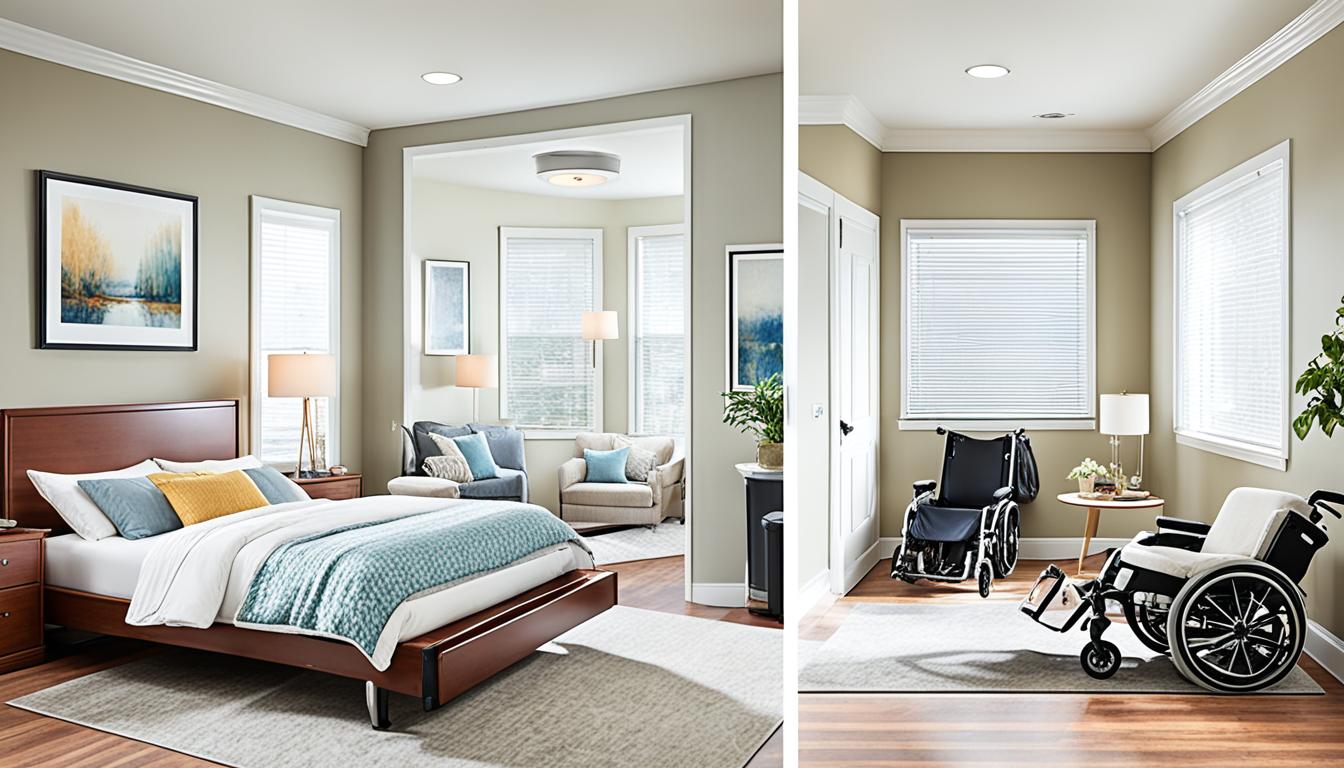Did you know that one-third of all non-fatal injuries in the U.S. happen when the elderly fall1? Making your bedroom accessible helps keep seniors safe, comfortable, and independent. It’s not just about looks; it’s about making a space that works for everyone. So, let’s start making your bedroom a safe and cozy place.
With accessible design ideas, you can make your bedroom both stylish and useful for everyone. It’s key for those who work from home, helping them stay focused and productive1. An ergonomic workspace cuts down on distractions and strain, making you more productive. Plus, calming designs help reduce stress, which is good for your creativity and clear thinking.
Good design also helps you sleep better, which is good for your brain and health. This means you’ll work better too.
Principles of Universal Design for Accessible Bedrooms
Creating an accessible bedroom starts with embracing universal design. This design makes spaces usable by all, no matter their age, size, ability, or disability2. By using universal design, bedrooms become welcoming for everyone. They remove barriers and make spaces intuitive and comfortable2.
Removing Physical Barriers for Maximum Usability
Universal design for accessible bedrooms includes wide doorways for wheelchairs and strollers2. It also means having curbless showers and single-handle faucets for easy water control2. Lever handles on doors and drawers make them easier to use for everyone2.
Creating Intuitive and Comfortable Spaces for All
Universal design is more than just removing barriers. It’s about making spaces intuitive and comfortable for everyone, now and in the future2. Features like light sensors save effort and electricity2. Slip-resistant flooring like cork adds safety and comfort2. Adjustable-height workstations and countertops suit standing or sitting3.
By using universal design, you can make your bedroom accessible and welcoming for all2.
| Universal Design Principle | Application in Accessible Bedrooms |
|---|---|
| Equitable Use | Designing spaces that are usable by people with diverse abilities |
| Flexibility in Use | Accommodating a wide range of individual preferences and abilities |
| Simple and Intuitive Use | Ensuring features are easy to understand, regardless of user experience, knowledge, language skills, or current concentration level |
| Perceptible Information | Communicating necessary information effectively to the user, regardless of ambient conditions or the user’s sensory abilities |
| Tolerance for Error | Minimizing hazards and the adverse consequences of accidental or unintended actions |
| Low Physical Effort | Ensuring features can be used efficiently and comfortably with a minimum of fatigue |
| Size and Space for Approach and Use | Providing appropriate size and space for approach, reach, manipulation, and use, regardless of the user’s body size, posture, or mobility |
By using these universal design principles, you can make a bedroom that welcomes everyone23.
Importance of Accessible Bedroom Design
Accessible bedroom design is key for people with disabilities, limited mobility, or those wanting to age in place. With the world’s older population set to double by 20504, making homes more accessible is crucial. By using universal design, bedrooms can meet the needs of many abilities, helping people live independently.
Accommodating Disabilities and Limited Mobility
About 15% of people worldwide, or one billion, have a disability4. 75 million need a wheelchair4. In the UK, 11 million live with a disability5, and 1.2 million use a wheelchair5. Sadly, 365,000 disabled people in the UK say their homes aren’t suitable for them5. Accessible bedrooms can help overcome these challenges, making life easier and more independent.
Facilitating Aging in Place
As we age, staying in our own homes is vital. With seniors set to double by 20504, making bedrooms accessible helps with aging in place. It keeps older adults independent and happy. A safe, comfortable, and accessible bedroom can be a sanctuary for life’s later years.
| Accessibility Feature | Recommended Dimensions |
|---|---|
| Wheelchair-accessible doorway | Minimum clear opening of 840mm5 |
| Door swing in accessible bedroom | Minimum width of 900mm5 |
| Ceiling clearance for door-opening devices | Minimum gap of 380mm5 |
| Wheelchair turning circle in bedroom | Minimum of 5×5′5 |
| Wardrobe rod height | 47-55″ above the floor5 |
| Electrical outlet placement | By the bed for easy access5 |
| Switch and handle alignment | Horizontally aligned for wheelchair users5 |
| Electrical sockets and connections | 900mm above the door5 |
| Appliance mounting height | 1000mm above the floor5 |
These design elements can turn bedrooms into spaces for all abilities, supporting independence54.
Accessible bedroom updates might seem expensive at first6, but there are ways to pay for them. Options include credit cards, loans, government help, and refinancing6. Making your bedroom accessible is a smart move for your long-term health and freedom.
Accessible Bedroom Design Ideas
Making a bedroom accessible is more than just about function. It’s about making a space that welcomes everyone. With smart lighting, easy controls, adjustable furniture, and smart storage, you can make your bedroom inclusive7.
For example, lights that are easy to turn on from a chair can make life easier7. Doors that are wide enough for wheelchairs make moving around simple7. Adding things like bedside commodes and safety rails helps with getting in and out of bed safely7.
Adjustable beds make it easy for wheelchair users to get into and out of bed7. Features like touchless handles and voice-controlled devices make the room easier to use8. Using different colors in the room helps people with vision loss see better8.
By adding these design ideas, you can make a bedroom that looks good and is easy for everyone to use. It’s about giving people with different needs independence, comfort, and a sense of home78.
| Accessible Bedroom Design Features | Benefits |
|---|---|
| Adjustable bed base | Enables easier transfers for wheelchair users |
| Lever-style or touchless hardware | Provides intuitive, hands-free control |
| Motion-activated sensors | Automate lighting and other functions for convenience |
| Voice-controlled smart home features | Allows for effortless control without manual operation |
| Contrasting colors in decor | Aids individuals with visual impairments in differentiating elements |
Ensuring Ample Space for Mobility
Creating an accessible bedroom means thinking carefully about how to use the space. Making the most of open space is key. This lets people move easily with wheelchairs or other aids.
Recommended Dimensions for Pathways and Clearances
For easy wheelchair movement, paths should be at least 42 inches wide and clear of walls9. This size ensures users of mobility aids can move around without hitting anything. Also, the bed should be 18 to 22 inches off the ground for easy getting in and out9.
| Design Element | Recommended Dimensions |
|---|---|
| Doorway Width | Minimum 32 inches wide9 |
| Turn Radius | Minimum 5-foot turn radius in open spaces9 |
| Countertop Height | Lowered for improved accessibility9 |
| Appliance Controls | Front-facing for enhanced accessibility9 |
| Bathroom Features | Roll-in or curbless showers, grab rails9 |
| Stairlifts | Consider adding for homes with stairs9 |
| Closet Organization | Lowered rods and shelving9 |
| Outdoor Surfaces | Wood or concrete patio areas9 |
Following these guidelines and design tips helps make a bedroom wheelchair-friendly. It ensures everyone can move around easily9.
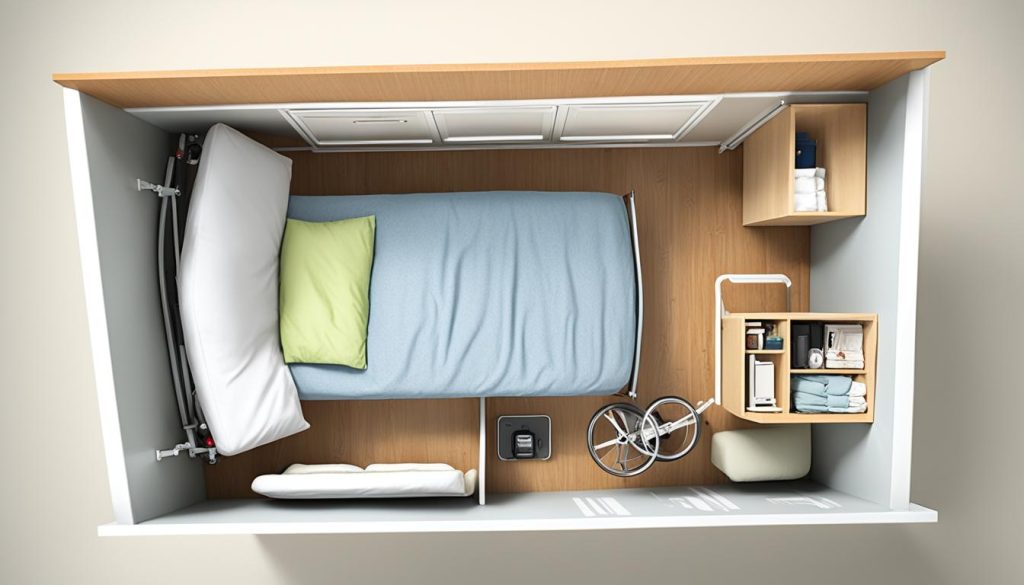
Selecting Appropriate Flooring Materials
Choosing the right flooring is key for an accessible bedroom. Stay away from carpets that could trip up people with mobility issues. Instead, go for hard floors like tile or wood, which are easier to move around on with help. Hardwood flooring is a top choice for many homeowners10, and laminate flooring is a more affordable option10. Cork flooring is strong and also helps with soundproofing and insulation10, making it great for an accessible bedroom.
For better grip and stability, think about putting a low-pile rug under the bed. Tile flooring is simple to keep clean since it doesn’t soak up liquids10, keeping the room clean and safe. Area rugs give the feel of carpet but are easy to change out10, letting you easily update the look of your space.
| Flooring Material | Average Cost per Sq. Ft. |
|---|---|
| Vinyl Planks and Tiles | $3.4211 |
| Tile | $3.6811 |
| Engineered Wood | $4.5211 |
| Prefinished Solid Wood | $5.4711 |
| Laminate | $2.8211 |
Choosing the right flooring makes a big difference in creating a safe, non-slip bedroom for those with mobility issues. Whether you pick tile, wood, or a mix, aim for a space that’s easy to move around in and is wheelchair-friendly101112.
Choosing Easy-to-Use Hardware and Fixtures
When designing an accessible bedroom, picking the right hardware and fixtures is key. Follow universal design principles and choose accessible bedroom hardware for everyone. Look for easy-grip door handles that can be opened with a closed fist13. This makes it easier for people with less strength or dexterity to use, making their experience better.
Think about universal design hardware for bedrooms that makes things easier and more convenient. Use lever-style handles on cabinets and drawers instead of knobs14. They’re simpler to hold and open. Add pull bars or D-shaped pulls on closets and dressers for a better grip. These features help make the bedroom more welcoming for everyone.
| Accessible Bedroom Hardware | Benefits |
|---|---|
| Lever-style door handles | Easier to grip and operate for individuals with limited dexterity |
| D-shaped cabinet and drawer pulls | Provide a secure and comfortable grip, suitable for all users |
| Automatic or motion-activated lighting | Eliminate the need for manually operating switches, enhancing accessibility |
| Adjustable bed frames and mattresses | Allow customization for optimal comfort and support, aiding in mobility |
Choosing easy-to-use hardware and fixtures makes a bedroom better for everyone. It ensures a smooth and easy living space. Accessible design is more than just about being useful. It’s about making everyone feel at ease and at home in their space.
Incorporating Smart Home Technology
Using smart home technology makes bedrooms more accessible15. Add voice-activated devices and wireless controls for easy management of lights, electronics, and more15. This lets people with limited mobility control their space easily from their bed, boosting independence and safety15.
Voice and Light Controls for Ease of Use
AI technology and voice control make smart homes better for energy use and living15. These homes use automated systems and connected devices to manage lights, security, and more15. Adding voice controls and wireless lights lets users easily change their environment, making living easier and more independent15.
| Smart Home Feature | Benefits |
|---|---|
| Voice-Activated Controls |
|
| Wireless Lighting |
|
Smart home tech brings more comfort and independence to living spaces15. AI for lighting control can set the right mood and improve the look of a room15. These designs make it easy to control lights, temperature, and more with just a button or voice command15. Staying up-to-date with smart home tech helps in choosing the right devices for your home15.
Optimizing Lighting for Visibility and Safety
For people with vision loss or aging eyes, accessible bedroom lighting is key. Using layered lighting helps balance light and visibility. This mix includes ambient, task, and accent lighting for different needs and activities16.
Layered Lighting and Adjustable Brightness
Dimmable lights and nightlights that turn on with motion let users change light levels easily. This is great for adjustable brightness for visually impaired people. They can set the lighting to what they like and need16.
- Use a mix of ambient, task, and accent lighting for a layered look.
- Choose dimmable lights for changing brightness to fit different eyesight.
- Put in motion-activated nightlights for soft light and safety at night.
With the right layered lighting for bedrooms, you get better visibility, clearer depth, and lower fall risk. This makes bedrooms safe and easy to get around for everyone16.
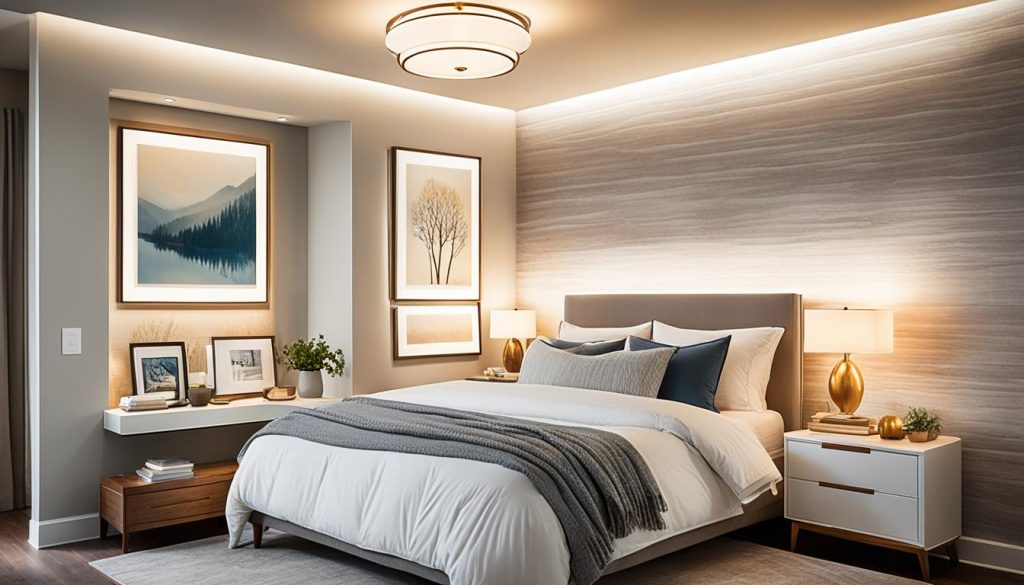
Considering an Adjustable Bed Base
An adjustable bed base can change the game for an accessible bedroom. These beds let you raise or lower the head and foot sections easily, helping you get in and out of bed17. Many mattresses work well with these bases, especially memory foam, hybrid, or innerspring ones with pocketed coils17. Adjustable beds also offer many health perks, like better circulation, less snoring, and back pain relief17. They make reading, watching TV, or getting into sleep position easier too17.
When looking at an adjustable bed base17, think about comfort first. There are many styles and materials for sheets that fit these beds17. Make sure you have enough space around your bed for moving and for the base’s features17. Also, check that your bed frame fits by looking at the dimensions. Frames without slats or bars work best, and17 tapestries are a cheap, easy way to change up your look17.
18Market research shows adjustable bed bases are getting more popular, with a 7% growth rate expected over five years18. About 65% of buyers look at design when picking furniture, showing how important looks are18. Around 42% of users pick bed skirts to hide the base, making it fit in with their decor18.
18Studies reveal 28% prefer a bold headboard to focus on another room feature, not the bed frame18. 15% mix their base with a stylish frame for a unified look18. And 10% add a bench at the bed’s foot to hide the frame and gain storage and style18.
19The Blissful Nights Split Head Flex Top King Size Adjustable Bed Frame Set comes with a 120-night trial19. Classic Brands has a 15″ Massaging Zero Gravity Adjustable Bed at Wayfair19. For elderly and disabled, the Home Caring Single Lifting Auxiliary Electric Medical Adjustable Bed is available on Alibaba.com19.
| Product | Features | Where to Buy |
|---|---|---|
| Wayfair Auxvasse Zero Gravity Adjustable Bed with Wireless Remote | Customizable sleeping experience | Wayfair |
| Member’s Mark King Luxury Adjustable Base | Restorative sleep with adjustable features | Sam’s Club |
| Alwyn Home’s Cushing 15″ Adjustable Bed with Remote | Wired adjustable bed frame with head articulation | Wayfair Canada |
| Darbydale Zero Gravity Adjustable Bed with Wireless Remote | Ultimate sleep experience with USB ports | Wayfair |
An adjustable bed base is great for an accessible bedroom, offering more comfort, mobility, and health benefits17. When choosing an adjustable bed, think about compatibility, design, and how it fits with your decor for a great sleep1718.
Maximizing Accessible Storage Solutions
Creating accessible storage options in the bedroom is key for people with limited mobility. Dressers with a height of 32 inches or less make it easy for wheelchair users to reach the top20. Hooks and hardware at 48 to 54 inches from the floor are also within easy reach20. Sliding closet doors and smart placement of rods and shelves boost accessibility and independence20.
Ideal Heights and Hardware for Dressers and Closets
For better accessibility, consider designs that meet different mobility needs. Use wall space with floating shelves or tall cabinets to increase storage20. Beds with drawers add more storage and functionality20. Under-bed storage keeps things tidy and clutter-free20.
In the closet, pull-out bins or baskets keep small items organized20. Custom organizers and extra shelves make the most of space for clothes20. Corner shelves or small dressers are great for storing items in tight spots20.
Think about creative storage solutions throughout the house. Built-in window seats can hide storage in small apartments20. Modern storage units with a simple design improve both looks and organization in a bedroom20. Tiered storage cabinets add versatility and keep things organized in a modern lifestyle20.
For a neat and accessible look, use furniture with hidden storage like beds with side drawers20. Decorative baskets or bins are a stylish way to keep things organized20.
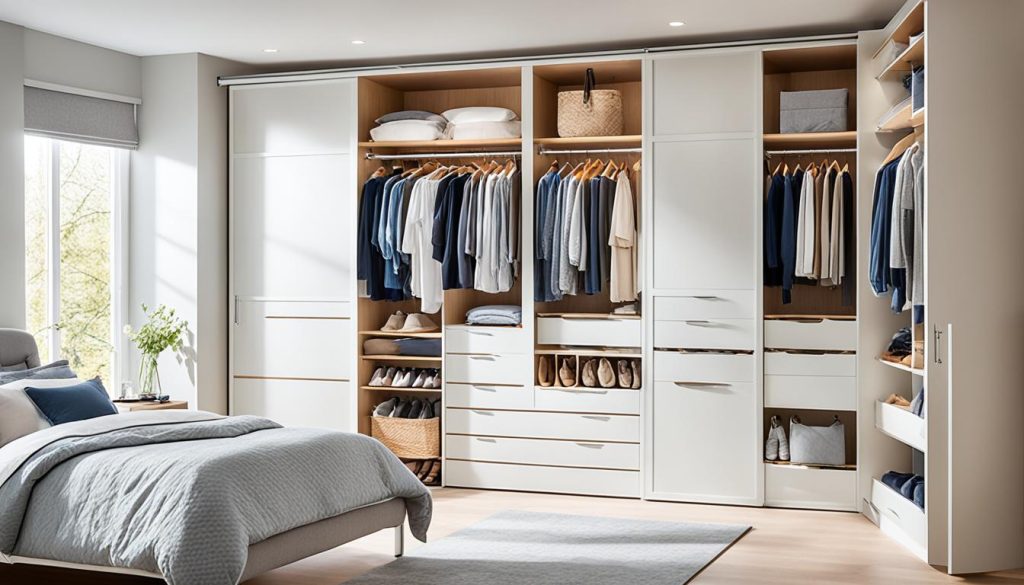
By designing accessible storage solutions, you can make a bedroom both useful and good-looking. It meets many mobility needs and tastes20. The main idea is to focus on convenience, organization, and looks to make a living space comfortable and welcoming for everyone20.
| Storage Solutions | Recommended Placement |
|---|---|
| Dressers | 32 inches or less in height |
| Hardware (hooks, shelves) | 48 to 54 inches from the floor |
| Closet Rods and Shelves | Strategically placed for accessibility |
| Floating Shelves and Tall Cabinets | Utilize wall space for maximizing storage |
| Beds with Drawers | Multifunctional designs for enhanced storage |
| Under-Bed Storage | Maintain a streamlined look and clear clutter |
| Closet Bins and Baskets | Store smaller items neatly |
| Custom Closet Organizers | Fully utilize space for organizing clothes |
| Corner Shelves and Dressers | Practical storage for awkward spaces |
| Window Seat Storage | Space-saving solutions for small apartments |
| Minimalist Storage Units | Enhance organization and aesthetics |
| Tiered Storage Cabinets | Offer versatility and organization |
| Beds with Side Drawers | Convenient hidden storage without compromising space |
| Decorative Baskets and Bins | Stylish storage and organization |
By using these accessible storage solutions, you can make a bedroom both good-looking and functional. It suits a wide range of mobility needs and tastes20.
Facilitating Safe Transfers with Bed Rails
Bed rails are key in making bedrooms safe for everyone, especially for those who move less easily. They help prevent falls and make moving from the bed to a wheelchair easier. Bed rails for accessible bedrooms add stability and support, helping users stay safe and independent21.
Every year, one in four people over 65 falls, leading to over 800,000 hospital visits for injuries21. Falls often cause serious injuries like broken hips or head wounds, showing how crucial safe transfers and bed mobility are21. Using safety measures can cut fall risks by up to 30%, as shown by the National Institute of Aging in 202021.
Good bed mobility is key to avoiding bed sores and other issues from being still for too long21. It makes moving safely to and from the bed easier, improving the life quality of older adults21. It also helps with proper lying down, which is good for breathing, digestion, blood flow, comfort, and sleep21.
Almost 30% of seniors struggle with moving and transferring, says the Journal of Geriatric Physical Therapy22. The National Council on Aging says 1 in 4 older adults falls yearly, often because of bad transfer methods22. A Bureau of Labor Statistics survey shows healthcare workers often get musculoskeletal injuries from lifting and moving patients. This shows how important secure bed transfer techniques are for both seniors and caregivers22.
| Transfer Types | Common Transfer Locations |
|---|---|
|
|
Injuries during transfers can vary, and common places for these include moving between different surfaces23. Safety tips for transfers focus on keeping everyone safe, addressing fears, considering client’s abilities, and using body mechanics correctly23.
Safe transfers rely on understanding body mechanics, like pelvic tilt and proper alignment, and using them during client interactions23. Falls during transfers can be dangerous for clients and caregivers, so it’s important to be careful23.
Good transfer strategies include planning, using the right equipment, and making sure the area is safe23. This includes using beds, wheelchairs, walkers, and other tools to help with moving safely23.
Positioning Switches and Outlets for Convenience
When making a bedroom accessible, it’s key to place electrical switches, outlets, and controls smartly. Put light switches where they’re easy to reach from bed. Think about using voice-activated or wireless controls for more ease24. Make sure outlets are at heights that don’t require bending, making it safer and more independent24.
The 2023 National Electrical Code says outlets should be 6 feet apart in living areas for best use24. It also requires GFCIs in kitchens, bathrooms, and garages, which have greatly reduced home electrocution cases24.
GFCI outlets should not be placed more than 20 inches above a countertop in kitchens.24 Bedrooms should have outlets on every wall, near the bed, and in closets for devices24. Bathrooms need outlets at least 6 feet from bathtubs and showers, and a foot from sinks24.
| Electrical Component | Recommended Placement |
|---|---|
| Outlets | |
| Switches |
Recommended outlet spots include living room walls, kitchen counters, and more24. By placing switches and outlets thoughtfully, you make your bedroom more accessible and convenient. Adding a bohemian touch can also make your space more comfortable and stylish26.
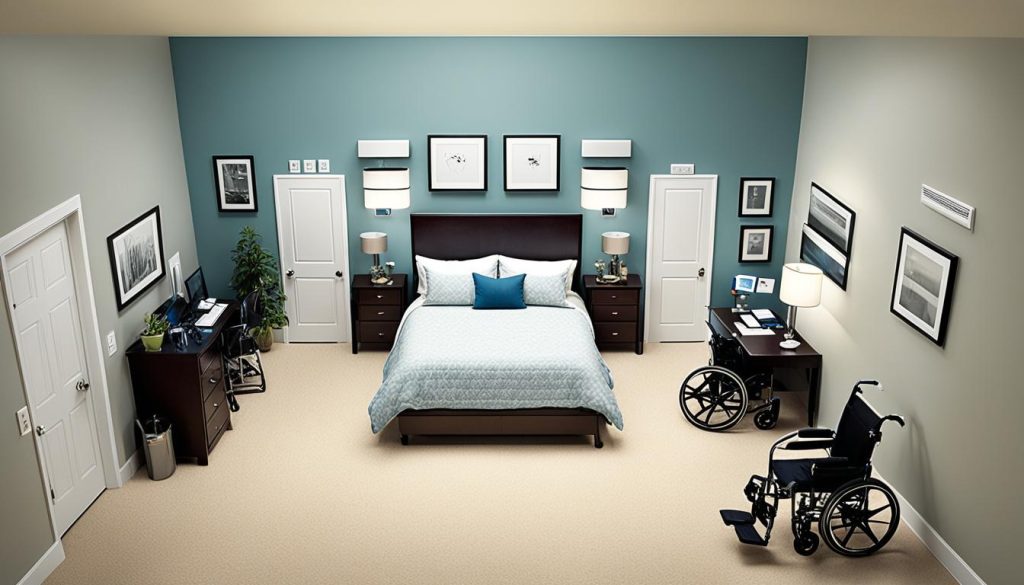
Designing Accessible Windows and Window Controls
Making a bedroom accessible goes beyond just the floor plan. It’s key to think about the design and how windows and their controls work for people with limited mobility or dexterity27.
For window design, choose wheelchair-accessible window design that makes things easy to use. Lever-style window handles work well because they can be opened with a closed fist. This means you don’t need fine motor skills or a lot of strength. And, placing these handles between 800 to 1000 mm from the floor makes sure everyone can open and close the windows easily27.
Adding easy-to-use window hardware in contrasting colors helps people with visual impairments find and use the controls. This smart design makes the bedroom more accessible and gives a sense of comfort and independence27.
By focusing on window controls for limited mobility, you make a space that welcomes everyone. This kind of accessibility makes the user experience better and makes the bedroom more welcoming for all27.
| Key Accessibility Features | Recommended Specifications |
|---|---|
| Window Handles | Lever-style, positioned 800-1000 mm from the floor |
| Window Hardware Contrast | Contrasting colors to aid visual impairments |
| Minimum Wheelchair Clearance | 60 inches wide by 56 inches deep |
By using these accessible design ideas in your bedroom, you make a space that meets the needs of everyone who uses it. This creates a place that’s inclusive and empowering for all2728.
Selecting Barrier-Free Furniture Layouts
When setting up furniture in an accessible bedroom, it’s key to make a layout that lets people move easily. Make sure there’s enough space for wheelchairs to turn around with a 5-foot radius29. Place furniture and remove cords that could cause tripping to keep the space safe29. Think about where to put dressers and wardrobes to help with moving around easily.
Turning Radius and Electrical Cord Management
The ADA says doorways should be at least 32 inches wide for easy access29. Wider doors make moving around easier for people using wheelchairs29. Make sure furniture doesn’t block paths and lower switches and thermostats for easier reach29.
Removing walls or extra furniture can make homes easier to get around in for people with mobility issues29. With good cord management, you can make a bedroom that’s great for wheelchairs and looks good too.
Using universal design and barrier-free layouts makes bedrooms accessible for everyone, no matter their mobility29. This way, your space is safe, comfy, and empowering for all visitors.
Incorporating Bedside Commodes for Convenience
Bedside commodes are great for making an accessible bedroom even better. They let people with limited mobility handle their bathroom needs from their bed. This keeps them independent and dignified30. A study by the National Institute on Aging found that most falls in the elderly happen in the bathroom. This shows why having accessible features like bedside commodes is so important30.
Putting a bedside commode next to the bed can make life easier for people with disabilities or those who are recovering. The Centers for Disease Control and Prevention (CDC) say that many people over 15 visit the emergency room each year because of bathroom injuries. Many of these are from falls30.
When picking a bedside commode, think about its weight capacity, stability, and how easy it is to use. Adding accessible features in the bedroom, like adjustable beds and controls, can make life better. A study found that this can improve comfort and independence by 75%31.
| Product | Weight Capacity | Key Features |
|---|---|---|
| Medline Heavy Duty Padded Drop-Arm Commode | 350 lbs | Sturdy support, padded seat |
| Medline Folding Steel Bedside Commode | 350 lbs | Foldable for storage, durable steel construction |
| Dynarex Bariatric Drop Arm Bedside Commode | 650 lbs | Heavy-duty support for bariatric needs |
| Drive Medical Folding Steel Bedside Commode Chair | 350 lbs | Robust assistance, foldable for easy storage |
| Medokare Foldable Bedside Commode Chair | N/A | Heavy-duty steel commode seat, foldable design |
Adding bedside commodes and other bathroom assistance in the bedroom makes an accessible bedroom more convenient and accessible.31
Planning for Future Needs and Aging in Place
When designing an accessible bedroom, think about your current and future needs. Use universal design to make a space that changes with you. The CDC defines ‘aging in place’ as living safely and comfortably at home, no matter your age or ability32. This way, your bedroom stays a cozy and useful place as you age, supporting your independence.
Think about adding features for aging issues like balance problems, vision loss, hearing loss, and more33. Smart home tech connects devices for easy control33, and universal design makes safe, comfy spaces for everyone33. Work with experts like CEAC, SHSS, and CAPS to make your home safe and ready for the future33.
Important changes for aging in place include grab bars, adjustable showerheads, lever handles, and non-slip floors33. Make sure doorways and hallways are wide enough for wheelchairs33. Add handrails in hallways and on stairs, especially to the bathroom33. With these plans, your bedroom will be great for years, no matter your abilities.
Source Links
- https://freedommobilitycenter.biz/how-to-make-your-bedroom-more-wheelchair-accessible/
- https://www.hgtv.com/design/remodel/interior-remodel/universal-design-ideas-for-the-home
- https://www.bhg.com/home-improvement/advice/planning/25-things-to-know-about-universal-design/
- https://www.saatva.com/blog/universal-design-tips/
- https://www.kbsa.org.uk/news-and-blog/blog/designing-an-accessible-bedroom/
- https://disabilityinsider.com/story/a-guide-to-creating-an-accessible-bedroom/
- https://www.oasisspace.com/blogs/healthcare/handicap-bedroom-suggestions
- https://www.homesandgardens.com/solved/how-to-make-a-bedroom-more-accessible
- https://www.braunability.com/us/en/blog/accessible-living/9-ways-to-create-a-handicap-accessible-home.html
- https://www.nationalfloorsdirect.com/learn/articles/How-to-Choose-Flooring-for-a-Bedroom-Your-Options-Explained
- https://www.consumerreports.org/home-garden/flooring/right-type-of-flooring-for-every-room-a9554244747/
- https://www.constructionresourcesusa.com/4-best-flooring-options-for-the-bedroom/
- https://inclinator.com/how-to-make-home-wheelchair-accessible/
- https://primeweld.com/blogs/news/diy-home-modifications-for-people-with-disabilities
- https://www.linkedin.com/pulse/smart-home-integration-incorporating-technology-your-design-joseph
- https://scienceoffalling.com/articles/6-practical-tips-on-lighting-for-reduced-fall-risk
- https://www.mattressfirm.com/blog/mattress-obsessed/styling-an-adjustable-bed
- https://www.ghostbed.com/pages/how-to-hide-adjustable-base
- https://www.pinterest.com/ideas/adjustable-beds/900397556214/
- https://www.decorilla.com/online-decorating/bedroom-storage-ideas/
- https://step2health.com/blogs/news/step-by-step-guide-to-safe-and-comfortable-bed-mobility-for-older-adults
- https://step2health.com/blogs/news/navigating-mobility-challenges-safe-bed-transfer-techniques-for-seniors
- https://www.otdude.com/reference-guides/proper-transfer-techniques/
- https://gcedestin.com/why-to-include-outlet-placement-in-interior-design/
- https://eshop.se.com/in/blog/post/setting-up-new-sockets-and-switches-a-design-guide.html
- https://erinzubotdesign.com/clever-ways-to-hide-outlets-in-the-kitchen/
- https://www.forbes.com/home-improvement/home/ways-to-make-home-accessible/
- https://www.roomsketcher.com/blog/how-to-design-a-wheelchair-accessible-senior-bathroom-with-roomsketcher/
- https://liveinplacedesigns.com/home-accessibility-design-for-wheelchair-users/
- https://www.familyshepherd.info/making-your-home-safer-a-guide-for-seniors-to-prevent-falls
- https://www.riversedgeltd.com/post/designing-for-accessibility-10-home-remodel-tips
- https://carolineondesign.com/ageing-in-place/
- https://udservices.org/aging-in-place-design/

